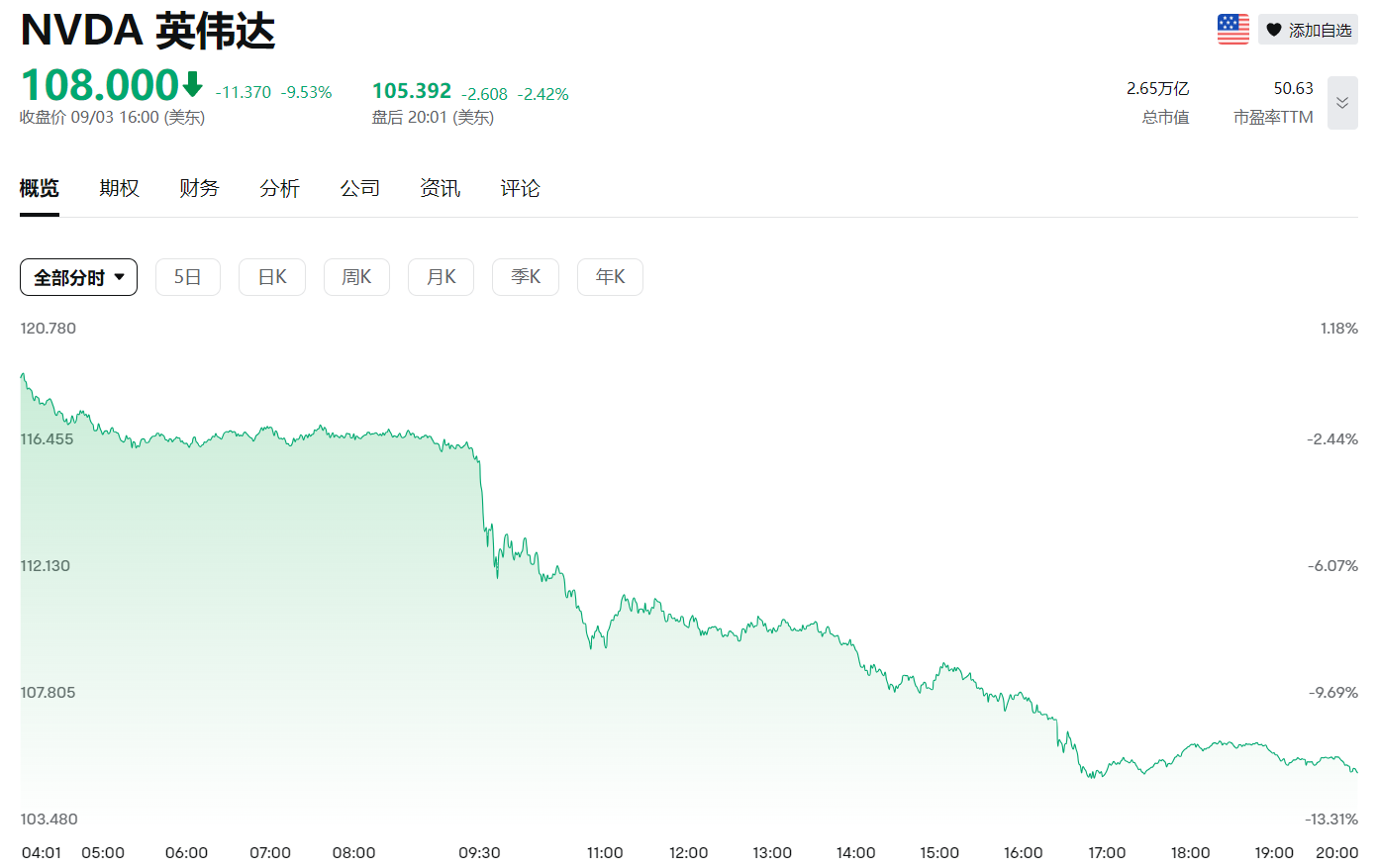Nvidia Leads Drop as Chip Stocks Face "Black Tuesday"
The U.S. Philadelphia Semiconductor Index closed down 7.8 percent to a more than three-week low on Tuesday. The index covers the 30 largest semiconductor stocks in the U.S. stock market.
On Tuesday (Sept. 3), chip stocks, led by NVIDIA, saw a sharp drop.
NVIDIA opened lower on Tuesday, closing down a whopping 9.5% at $108, evaporating about $279 billion in market value on the day, the company's biggest single-day loss ever.

Meanwhile, semiconductor stocks generally fell sharply. The Philadelphia Semiconductor Index closed down 7.8% on Tuesday to a more than three-week low. The index covers the 30 largest semiconductor stocks in the U.S. stock market.
On Tuesday, chip design company Arm fell 6.9 percent, wireless chip leader Qualcomm dropped 6.9 percent, shares of memory chip giant Micron Technology fell 8 percent, and Intel shares slumped nearly 9 percent more. In addition, AMD fell 7.8 %, Broadcom, which will report earnings on Thursday, fell 6.2%, and Marvell Technology fell 8.2%. Chip foundry TSMC's US shares also fell 6.5 percent to $160.49.
Behind this near-total decline in chip stocks lies a number of bearish news.
First, macroeconomic uncertainty is increasing. On Tuesday, the ISM released the August manufacturing PMI report and S&P Global released the final reading of the manufacturing PMI were lower than market expectations.
ISM's report showed that the manufacturing PMI rose from 46.8 in July to 47.2 in August, slightly below analysts' expectations of 47.5. In the report, manufacturing orders and production indexes both fell. In response, ISM commented, “Businesses' willingness to invest in capital and inventories continues to be subdued and demand remains weak due to ongoing federal monetary policy and election uncertainty.”
The S&P Global report also brought bad news. The data showed that the S&P Global Manufacturing PMI fell to 47.9 in August from 49.6 in July, below analysts' expectations of 48.
Both PMI figures released on the same day came in below expectations, allowing the risk of a slowdown in the U.S. economy to stir up investor nervousness once again. Mizuho Securities trading department analyst Jordan Klein Jordan Klein said in a report, in the case of economic “hard landing” risk is increasing, investors may want to reduce the investment in semiconductor stocks.
Second is the industry news. On Tuesday, the U.S. Semiconductor Industry Association (SIA) released data showing that July chip sales lower than the seasonal level. UBS analyst Timothy Arcuri Timothy Arcuri said in a client report that chip sales fell 11.1% from June to July, below the five- and 10-year average.
Memory was the main downside driver,” Arcuri said. Key segments including MCUs (microcontroller units), DSPs (digital signal processors) and analog all declined worse than their respective seasonal trends over the past 5 and 10 years.”

In addition, industry trendsetter NVIDIA's stock has been underperforming since it sent out its earnings report last week.
In its earnings report, NVIDIA mentioned that it expects revenue in the third quarter of fiscal 2025 to be around $32.3 billion-$32.7 billion, an increase of about 80% year-on-year, or an end to the company's five consecutive quarters of triple-digit growth.
In addition, NVIDIA's gross margin for the second quarter was 75.7%, down from 78.9% in the previous quarter. The company's management said it expects gross margins to stabilize in the mid-70% range for the current fiscal year, which means gross margins could decline further in the coming quarters.
The figures have raised investor concerns about cooling demand for AI chips and unease about the company's ability to maintain its strong momentum. The stock is now down about 20% from its all-time high closing price of $135.58.
Paul Nolte, Market Strategist and Senior Wealth Manager at Murphy & Sylvest Wealth Management, said, “Outside of the big tech companies acquiring each other, we haven't really seen AI catch on across the economy. The ROI on all this spending is still a big question mark. If you look back at the age of the Internet, you'll see that the first winners of the Internet weren't always the ultimate winners.”
·Original
Disclaimer: The views in this article are from the original Creator and do not represent the views or position of Hawk Insight. The content of the article is for reference, communication and learning only, and does not constitute investment advice. If it involves copyright issues, please contact us for deletion.